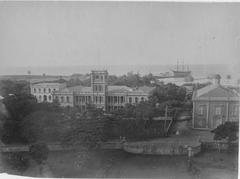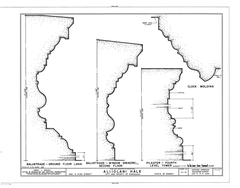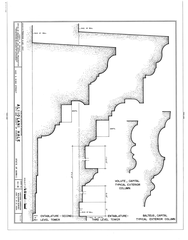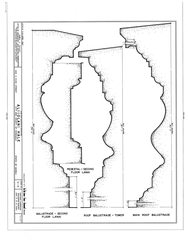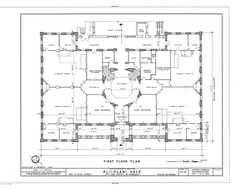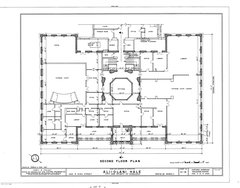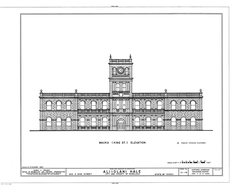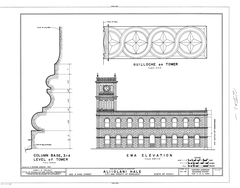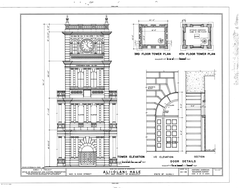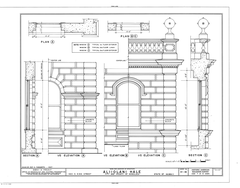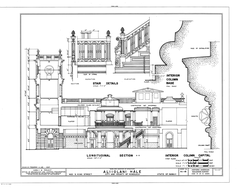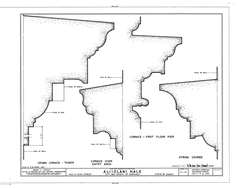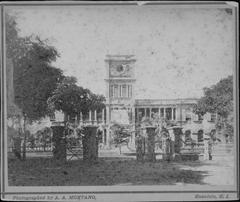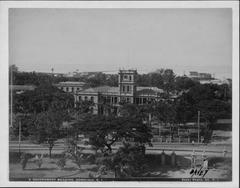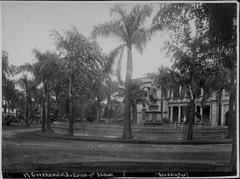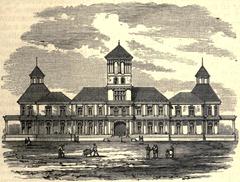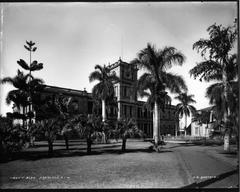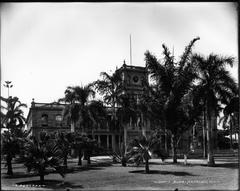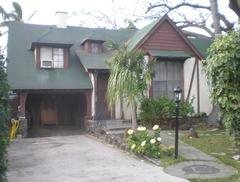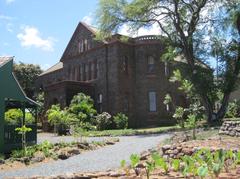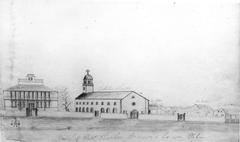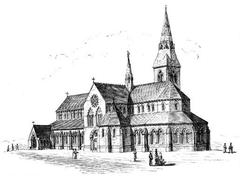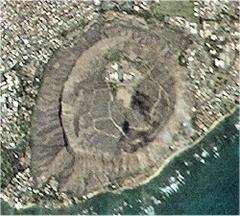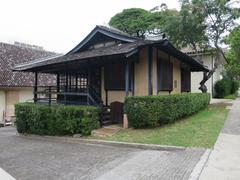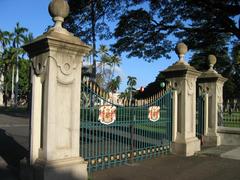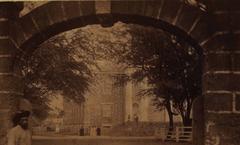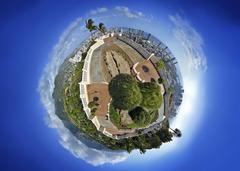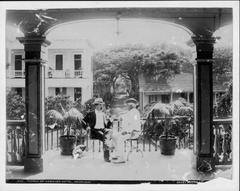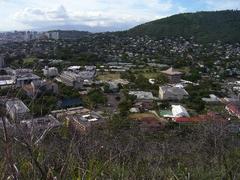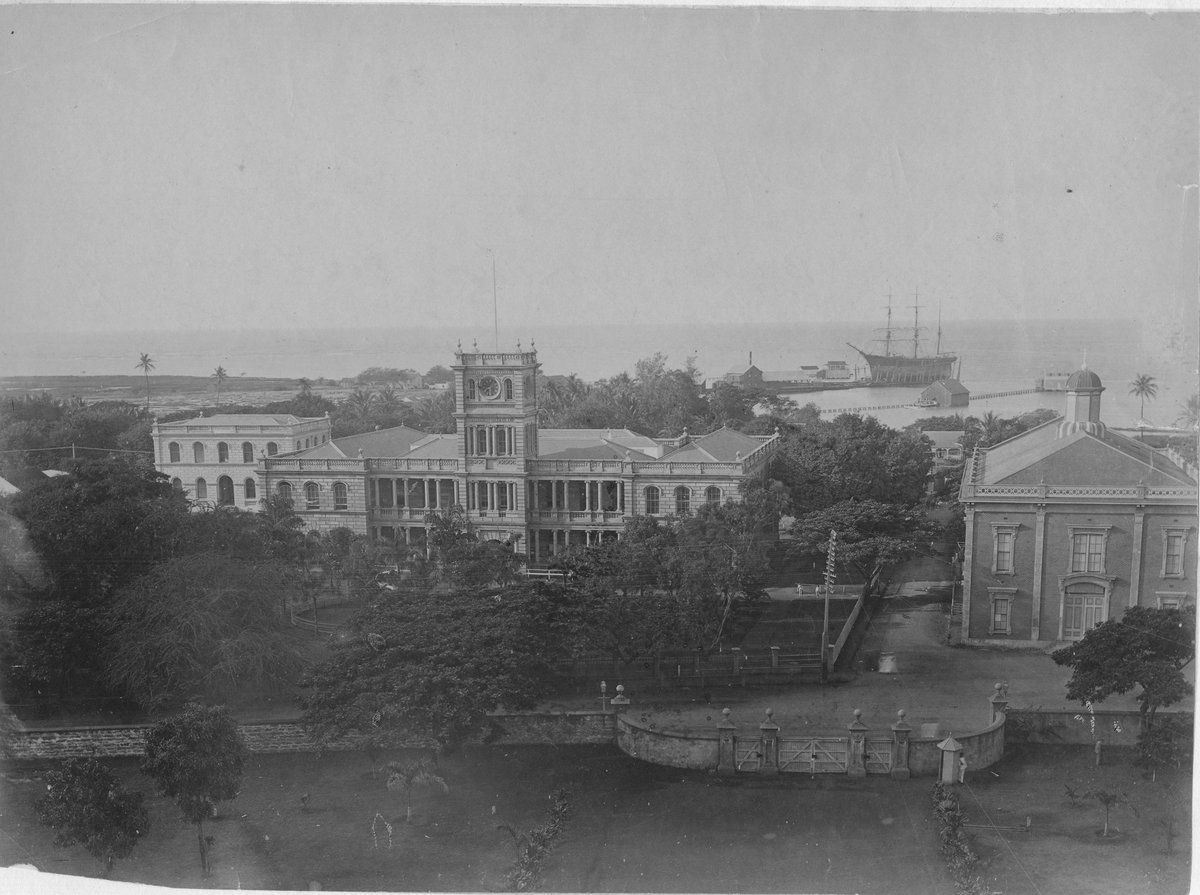
Aliʻiōlani Hale: Visiting Hours, Tickets, and Historical Sites in Honolulu – The Complete Guide
Date: 15/06/2025
Introduction
Aliʻiōlani Hale is an architectural and cultural landmark in downtown Honolulu, renowned as the seat of Hawaiʻi’s Supreme Court and a vibrant symbol of the islands’ legal, political, and royal heritage. Commissioned by King Kamehameha V in the early 1870s and completed in 1874, the building showcases Italian Renaissance Revival architecture and stands proudly beside the famous gold-leaf statue of King Kamehameha I. Today, Aliʻiōlani Hale houses the King Kamehameha V Judiciary History Center, offering exhibits and educational programs that trace Hawaiʻi’s journey from monarchy to modern judicial state. With free public admission, wheelchair accessibility, and proximity to other major historical sites, Aliʻiōlani Hale is an essential destination for travelers, history enthusiasts, and anyone eager to experience the unique cultural fabric of Honolulu. (Only in Hawaii; Judiciary History Center; Hawaii News Now; Lonely Planet)
Table of Contents
- Historical Overview
- Visiting Hours, Tickets, and Tours
- Accessibility and Visitor Amenities
- Nearby Attractions and Travel Tips
- Visuals and Virtual Resources
- Special Events and Educational Programs
- Frequently Asked Questions (FAQ)
- Contact Information
- Conclusion and Final Tips
- References
Historical Overview
Origins and Construction
Aliʻiōlani Hale, meaning “House of the Heavenly King,” was commissioned by King Kamehameha V in 1871 as part of his vision to modernize the Hawaiian Kingdom’s government. Originally intended as a royal palace, the building was repurposed before completion to serve as the seat of the government and judiciary. The cornerstone was laid in 1872, with completion and dedication following in 1874 under King David Kalākaua (Only in Hawaii; SAH Archipedia; Hawaii News Now). Australian architect Thomas Rowe designed the building, and construction introduced modern materials and techniques to Hawaiʻi, including Portland cement and locally quarried coral stone.
Architectural Significance
Aliʻiōlani Hale is a prime example of Italian Renaissance Revival architecture, notable for its symmetrical façade, four-story clock tower, arched windows, and Ionic columns. The iconic clock tower, with its imported English clock, is a visual landmark in downtown Honolulu. The building’s original H-shaped plan was later expanded, and major interior renovations in the early 20th century added a rotunda with a stained glass skylight and a cast-iron staircase, preserving its grandeur and functionality (SAH Archipedia; Hawaii News Now).
Role in Hawaiian History
Aliʻiōlani Hale played a pivotal role in Hawaiʻi’s political evolution. From its inception, it housed the Kingdom’s executive, legislative, and judicial branches. The historic events of January 17, 1893, when the overthrow of the Hawaiian monarchy was declared in front of the building, marked a turning point in Hawaiʻi’s history (The Bill Beaver Project). Since then, Aliʻiōlani Hale has continuously served as the judiciary’s headquarters, now home to the Hawaii State Supreme Court and the Judiciary History Center, which documents the islands’ legal transformations and the integration of Hawaiian and Western legal traditions (Judiciary History Center).
Visiting Hours, Tickets, and Tours
- Visiting Hours: Monday through Friday, 8:00 AM to 4:00 PM (closed on public holidays).
- Admission: Entry to both Aliʻiōlani Hale and the Judiciary History Center is free—no tickets are required.
- Self-Guided Tours: Visitors may explore the exhibits and public areas independently.
- Guided Tours: Group tours and educational programs are available by reservation. It is recommended to contact the Judiciary History Center in advance to secure a slot, especially for school groups or during special events (Judiciary History Center; USA Today 10Best).
Accessibility and Visitor Amenities
Aliʻiōlani Hale is wheelchair accessible, with ramps, elevators, and accessible restrooms. For visitors requiring additional accommodation, it is best to contact the ADA Coordinator at the Hawaii State Judiciary Office on Equality and Access to the Courts prior to your visit (ADA Notice). The building is air-conditioned, and restrooms are available. While there is no café on the premises, downtown Honolulu offers many dining options within walking distance.
Nearby Attractions and Travel Tips
Aliʻiōlani Hale is part of Honolulu’s historic core and is surrounded by important sites:
- ʻIolani Palace: The only royal residence in the United States.
- Kawaiahaʻo Church: Referred to as Hawaiʻi’s “Westminster Abbey.”
- King Kamehameha I Statue: A centerpiece for cultural celebrations, notably King Kamehameha Day (June 11).
- Hawaiian Mission Houses Historic Site: Explore missionary-era history.
- Honolulu Museum of Art: Features local and global art collections.
Travel Tips:
- Plan your visit during the morning for cooler temperatures and fewer crowds.
- Metered parking is limited; consider using public transportation or rideshare options.
- Allow 1–2 hours to explore Aliʻiōlani Hale and adjacent landmarks.
- Visitors are encouraged to join guided tours for a deeper understanding of the building’s history and significance.
(Lonely Planet; USA Today 10Best)
Visuals and Virtual Resources
- Photography: Visitors may photograph the exterior and most interior public areas. The King Kamehameha I statue and the façade are especially popular photo spots. Restrictions may apply in courtrooms or during proceedings.
- Virtual Tours: The Judiciary History Center’s website offers virtual tours and interactive maps for those who wish to preview the site or plan their visit. (Judiciary History Center Virtual Tour)
Special Events and Educational Programs
Aliʻiōlani Hale is a hub for public programs, lectures, and dramatic reenactments related to Hawaiʻi’s legal and political history. Educational workshops and mock trials are frequently held for students and the general public, especially in the historic 1913 Courtroom. The building is central to annual cultural events such as King Kamehameha Day, when the statue is festooned with lei and the grounds host celebrations of Hawaiian heritage (Hawaii News Now; Judiciary History Center Events).
Frequently Asked Questions (FAQ)
Q: What are Aliʻiōlani Hale’s visiting hours?
A: Monday to Friday, 8:00 AM to 4:00 PM, closed on public holidays.
Q: Is there an admission fee or are tickets required?
A: Admission is free for all visitors; no tickets are necessary.
Q: Are guided tours available?
A: Yes, by advance reservation through the Judiciary History Center.
Q: Is the building accessible for visitors with disabilities?
A: Yes, with ramps, elevators, and accessible restrooms.
Q: Can photography be taken inside the building?
A: Yes, in most public areas, but restrictions may apply in courtrooms or during official proceedings.
Q: What nearby attractions should I visit?
A: ʻIolani Palace, Kawaiahaʻo Church, King Kamehameha I Statue, Hawaiian Mission Houses, and Honolulu Museum of Art.
Contact Information
- Phone: (808) 539-4999
- Email: [email protected]
- Website: www.jhchawaii.net
- Address: 417 S King St, Honolulu, HI 96813
Conclusion and Final Tips
Aliʻiōlani Hale is not just a historic building—it is a living monument that embodies Hawaiʻi’s royal aspirations, its political transformations, and its enduring commitment to justice and cultural identity. With free admission, comprehensive exhibits, accessibility features, and central location amidst Honolulu’s most treasured historical sites, a visit here is both educational and inspiring. For the best experience, plan ahead, consider joining a guided tour, and check for special events or cultural celebrations during your stay.
Enhance your visit by downloading the Audiala app for audio tours, maps, and up-to-date information on Aliʻiōlani Hale and other iconic Hawaiian destinations. Follow official sites and social media for event updates, and immerse yourself in the rich history and vibrant present of this Honolulu landmark.
References
- Only in Hawaii – Aliʻiōlani Hale: Visiting Hours, Tickets, and History
- SAH Archipedia – Aliʻiōlani Hale Architectural and Historical Overview
- Hawaii News Now – Historic Building Celebrates 150 Years
- Judiciary History Center – Aliʻiōlani Hale Venue
- AFAR – History, Art, and Architecture on Oahu
- The Bill Beaver Project – Aliiolani Hale Cultural and Political History
- Go Visit Hawaii – Aliiolani Hale Visitor Information
- Lonely Planet – Aliʻiōlani Hale Visitor Guide
- USA Today 10Best – Best Attractions Near Honolulu Cruise Port
- Shaka Guide – Historic Downtown Honolulu Tour
- Judiciary History Center – Public Programs and ADA Notice
